Reflecting on the life and legacy of British photographer Philip Wolmuth, who used the camera as a tool of liberation in the fight for social justice.

You’re getting blind.
Don’t miss the best of visual arts. Subscribe for $9 per month or $108 $90 per year.
Already suscribed ?



